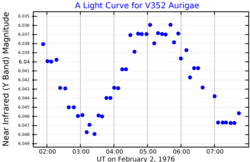
Summary
V352 Aurigae is a variable star in the northern constellation of Auriga. It dimly visible to the naked eye with an apparent visual magnitude that ranges from 6.13 down to 6.18. According to the Bortle scale, it is faintly visible to the naked eye from dark rural skies. The star is located at a distance of approximately 970 light years from the Sun based on parallax,[8] but is drifting closer with a radial velocity of −7 km/s.[3]
| Observation data Epoch J2000 Equinox J2000 | |
|---|---|
| Constellation | Auriga |
| Right ascension | 06h 55m 14.65813s[2] |
| Declination | +43° 54′ 36.1052″[2] |
| Apparent magnitude (V) | 6.16[3] (6.13 – 6.18)[4] |
| Characteristics | |
| Spectral type | A9III[5] |
| U−B color index | 0.21[6] |
| B−V color index | 0.314±0.015[3] |
| Variable type | δ Sct[4] |
| Astrometry | |
| Radial velocity (Rv) | −7.0±2.9[3] km/s |
| Proper motion (μ) | RA: +1.795[2] mas/yr Dec.: −6.908[2] mas/yr |
| Parallax (π) | 3.3542 ± 0.0361 mas[2] |
| Distance | 970 ± 10 ly (298 ± 3 pc) |
| Absolute magnitude (MV) | −1.26[3] |
| Details | |
| Mass | 1.57[7] M☉ |
| Radius | 12.86+8.99 −2.03[8] R☉ |
| Luminosity | 242.2±7.7[8] L☉ |
| Surface gravity (log g) | 3.79[9] cgs |
| Temperature | 6,350+568 −1,479[8] K |
| Metallicity [Fe/H] | 0.00[9] dex |
| Rotational velocity (v sin i) | 36[10] km/s |
| Age | 998[11] Myr |
| Other designations | |
| Database references | |
| SIMBAD | data |
The stellar classification of this star is A9III,[5] which matches an A-type star with the luminosity class of an evolved giant star. It is listed as a spectral standard for stars of that class,[5] although other researchers have classed it as F0II-III[13] or F1IV.[14]
V352 Aurigae is a low amplitude Delta Scuti variable with a period of 4.1 hours,[4] which means the variability is caused by the rotation of the host star in combination with localized regions of activity.[15] The star has 13 times the radius of the Sun and is radiating 242 times the Sun's luminosity from its photosphere at an effective temperature of 6,350 K.[8] It is unusually luminous for a Delta Scuti variable.[16] It is also suspected of being a chemically peculiar star of the Delta Delphini type,[17] although the anomalies are not pronounced.[16]
References edit
- ^ Kurtz, D. W. (December 1977), "HR 2557: a luminous delta Scuti star", Publications of the Astronomical Society of the Pacific, 89: 941–944, Bibcode:1977PASP...89..941K, doi:10.1086/130252, S2CID 120264338.
- ^ a b c d e Vallenari, A.; et al. (Gaia collaboration) (2023). "Gaia Data Release 3. Summary of the content and survey properties". Astronomy and Astrophysics. 674: A1. arXiv:2208.00211. Bibcode:2023A&A...674A...1G. doi:10.1051/0004-6361/202243940. S2CID 244398875. Gaia DR3 record for this source at VizieR.
- ^ a b c d e Anderson, E.; Francis, Ch. (2012), "XHIP: An extended hipparcos compilation", Astronomy Letters, 38 (5): 331, arXiv:1108.4971, Bibcode:2012AstL...38..331A, doi:10.1134/S1063773712050015, S2CID 119257644.
- ^ a b c Samus, N. N.; et al. (2017), "General Catalogue of Variable Stars", Astronomy Reports, 5.1, 61 (1): 80–88, Bibcode:2017ARep...61...80S, doi:10.1134/S1063772917010085, S2CID 125853869.
- ^ a b c Morgan, W. W.; Abt, H. A. (February 1972), "The spectral classification of the F stars of intermediate luminosity", Astronomical Journal, 77: 35–37, Bibcode:1972AJ.....77...35M, doi:10.1086/111242.
- ^ Mendoza, E. E.; Gomez, V. T.; Gonzalez, S. (June 1978), "UBVRI photometry of 225 AM stars", Astronomical Journal, 83: 606–614, Bibcode:1978AJ.....83..606M, doi:10.1086/112242.
- ^ Stassun, Keivan G.; Oelkers, Ryan J.; Pepper, Joshua; Paegert, Martin; De Lee, Nathan; Torres, Guillermo; Latham, David W.; Charpinet, Stéphane; Dressing, Courtney D.; Huber, Daniel; Kane, Stephen R.; Lépine, Sébastien; Mann, Andrew; Muirhead, Philip S.; Rojas-Ayala, Bárbara; Silvotti, Roberto; Fleming, Scott W.; Levine, Al; Plavchan, Peter; the TESS Target Selection Working Group (2018), "The TESS Input Catalog and Candidate Target List", The Astronomical Journal, 156 (3): 102, arXiv:1706.00495, Bibcode:2018AJ....156..102S, doi:10.3847/1538-3881/aad050, S2CID 73582386.
- ^ a b c d e Brown, A. G. A.; et al. (Gaia collaboration) (August 2018). "Gaia Data Release 2: Summary of the contents and survey properties". Astronomy & Astrophysics. 616. A1. arXiv:1804.09365. Bibcode:2018A&A...616A...1G. doi:10.1051/0004-6361/201833051. Gaia DR2 record for this source at VizieR.
- ^ a b Koleva, M.; Vazdekis, A. (February 2012), "Stellar population models in the UV. I. Characterisation of the New Generation Stellar Library", Astronomy & Astrophysics, 538: A143, arXiv:1111.5449, Bibcode:2012A&A...538A.143K, doi:10.1051/0004-6361/201118065, S2CID 53999614.
- ^ Royer, F.; et al. (2002), "Rotational velocities of A-type stars in the northern hemisphere. II. Measurement of v sin i in the northern hemisphere", Astronomy and Astrophysics, 393 (3): 897–911, arXiv:astro-ph/0205255, Bibcode:2002A&A...393..897R, doi:10.1051/0004-6361:20020943, S2CID 14070763.
- ^ Gontcharov, G. A. (2012), "Dependence of kinematics on the age of stars in the solar neighborhood", Astronomy Letters, 38 (12): 771–782, arXiv:1606.08814, Bibcode:2012AstL...38..771G, doi:10.1134/S1063773712120031, S2CID 118345778.
- ^ "V352 Aur", SIMBAD, Centre de données astronomiques de Strasbourg, retrieved 2021-03-07.
- ^ Gray, R. O; Napier, M. G; Winkler, L. I (2001), "The Physical Basis of Luminosity Classification in the Late A-, F-, and Early G-Type Stars. I. Precise Spectral Types for 372 Stars", The Astronomical Journal, 121 (4): 2148, Bibcode:2001AJ....121.2148G, doi:10.1086/319956.
- ^ Abt, Helmut A.; Morrell, Nidia I. (July 1995), "The Relation between Rotational Velocities and Spectral Peculiarities among A-Type Stars", The Astrophysical Journal Supplement Series, 99: 135, Bibcode:1995ApJS...99..135A, doi:10.1086/192182.
- ^ Bush, Tabitha C.; Hintz, Eric G. (September 2008), "Rotational Velocity Determinations for 118 delta Scuti Variables", The Astronomical Journal, 136 (3): 1061–1066, Bibcode:2008AJ....136.1061B, doi:10.1088/0004-6256/136/3/1061.
- ^ a b Kurtz, D. W. (1977), "HR 2557 : A luminous del SCT star", Publications of the Astronomical Society of the Pacific, 89: 941, Bibcode:1977PASP...89..941K, doi:10.1086/130252.
- ^ Renson, P.; Manfroid, J. (2009), "Catalogue of Ap, HGMN and Am stars", Astronomy and Astrophysics, 498 (3): 961, Bibcode:2009A&A...498..961R, doi:10.1051/0004-6361/200810788.
External links edit
- HR 2557
- Image V352 Aurigae



